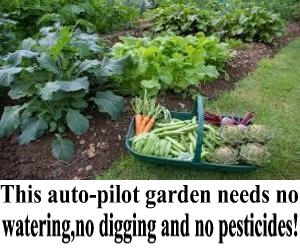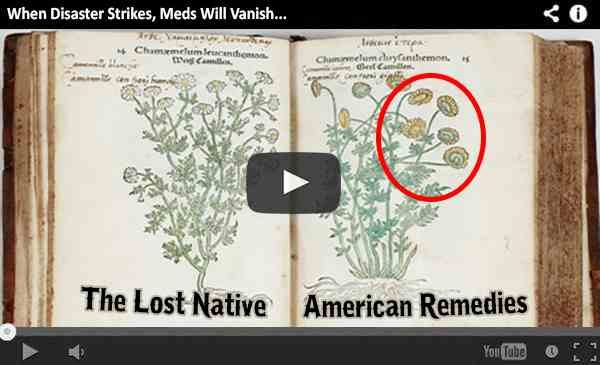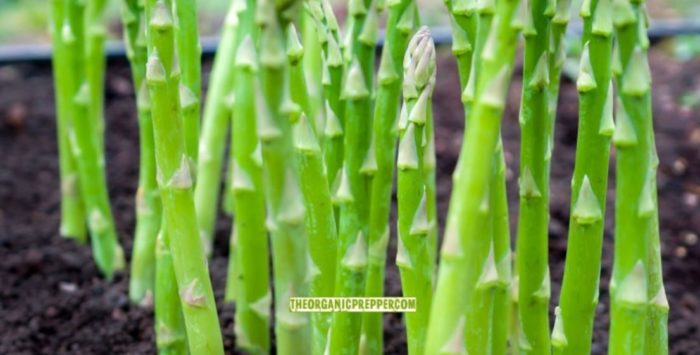I love gardening. It’s fun, it’s rewarding, and it saves money. However, it’s only useful for prepping purposes in the long term if you focus primarily on a self-sufficient garden. If you rely on bags of fertilizer, soil, and seeds every year, grid interruptions and supply chain issues can put a stop to your fun hobby.
We saw the beginnings of this last year with seed shortages. In my area, seed supplies have been better than last year. But I am still always looking for ways to make my property more of a closed-loop. Between using perennial plants, seed saving, and on-site fertilizer production, I have made a lot of progress.
Perennials are long-term investments for a self-sufficient garden.
Rhubarb has been growing for about a month now. My first asparagus spears are just beginning to emerge. I planted one rhubarb crown and maybe seven asparagus crowns in 2014. You can’t harvest rhubarb the first year. And asparagus needs to wait for three years before harvesting. But if you have a place in which you plan to hunker down, they’re well worth it.

Since 2017, I have been getting several servings of asparagus a week for about two months a year. Other than the occasional weeding and watering, I’ve had no work or effort other than initially buying and planting the crowns.
This past winter, I dug up my rhubarb root and split it into pieces, hoping the “crown division” process was as easy as all the gardening books assured me. It was. My one original rhubarb plant has now turned into seven rhubarb plants. I won’t harvest any this year, but next year, I should be drowning in it, which is fine with my kids and me because we love rhubarb. And, like the asparagus, it has just become part of the landscape.
Are things like asparagus, rhubarb, mint, chives, and horseradish staples? Of course not. I have bags of dried beans, meat in the freezer and on the hoof, just like many of the people reading this site. But my garden plants can make the dried beans a lot more enjoyable. And they’ll come back every year whether I put a lot of work into them or not, which is certainly in line with the goal of a self-sufficient garden.
I planted chives last year, and the horseradish roots I put in over the winter have just started to come up. We’ll see how these do in the long run. Mint is everywhere. I planted it in 2015, and it would take over if I didn’t pull out big chunks every year.
Many of the things we enjoy eating every year are annuals
For annuals, you can save seed. Suzanne Ashworth’s book Seed to Seed is a great guide to get started saving seed. I regularly save tomato, pumpkin, and carrot seed. Seeds are not super expensive. I buy seeds every year because it’s fun to experiment and try new things. (The Organic Prepper recommends Seeds for Generations for your heirloom seeds – they are a small family business in Virginia). But saving some seeds can be a lifesaver. For example, a few years ago, some disease wiped out half my tomato plants.
I saved seeds from the ones that survived and have never had that disease since. Every garden has its little quirks, and over time, saving seeds from your healthiest plants can produce individuals exceptionally well suited to your garden.
Depending on your climate, you may be able to let some annuals go to seed. I only do this with herbs. With vegetables, growing them in the same place every year will usually lead to disease in the long term. Of course, you could let them sprout and then pick them up and move them when they’re small. But my growing season is too short for tomatoes to fruit unless I start them inside, which is the only vegetable I’ve had that will volunteer outdoors here in Colorado.
Japanese planting rings
When I lived in Texas, I had a Japanese planting ring. By the time we moved, I didn’t even bother planting in it. So many seeds would sprout out of it that it was a simple matter of pulling out the ones I didn’t want.
Japanese planting rings are great for people living in the suburbs. Howard Garrett talks about them in his book Texas Gardening the Natural Way.
You start by making two concentric circles. The outer wall can be retaining wall bricks, and the inner one is chicken wire a few feet high. Toss your compost into the chicken wire and then plant outside of the chicken wire. When you water the compost, it drains down and waters the plants you’ve put in just outside it.
Not only is it an attractive way to compost, but it also gives your plants an extra nutrient boost every time you water. And we eventually got volunteers from our compost. One of the guajillo chiles we’d gotten at Food Town sprouted and turned into a five-foot-tall beast. It was excellent, and it came from our food waste!
We also had tomatoes and squash grow on their own. We would let some basil go to seed, as well, and that would regrow every year in Texas.
No-till can work for you
I don’t get veggies in Colorado, but parsley, dill, and cilantro will reseed themselves. I don’t deep till most years. I generate enough compost on-site with my animals that I simply layer it over.
The Organic No-Till Farming Revolution: High-Production Methods for Small-Scale Farmers by Andrew Mefferd goes into great detail about this.
No-till won’t work for everyone, but I have had good results. I live in a semi-arid region, which means I can suppress weeds simply by not watering. No-till is definitely worth researching.
The biggest complaint about no-till is usually the amount of compost required to make it work. Since I have livestock, I produce a lot of compost on-site simply by piling soiled bedding, watering, and turning it occasionally. However, if you do not have livestock, don’t despair. You still have options.
A shocking amount of yard waste winds up in landfills
When I lived in a suburban neighborhood in Texas, my neighbors would put all kinds of things out on the curb. It was pretty typical, if you needed furniture, to simply drive around the night before trash day and see what other people were throwing out. That’s how I got my media armoire, as well as a lovely china cabinet. They even match.
But if you wanted to build your own soil, you could just as easily grab bags of yard waste, assuming there are no laws against that kind of thing. I know in Texas, it was a non-issue.
If you don’t consider garbage-snatching an option, you could simply ask friends and neighbors for their yard waste. Pay attention to food waste. Most people throw away more than they realize. Mixed with lawn waste, it can produce good compost.
Or you could volunteer at a park
Depending on where you live, this can pay off in a variety of ways.
I’ve brought back downed leaves and Christmas trees for my goats from the park where my children and I volunteer. My park also has wild plum trees growing; we received permission from the ranger to harvest as many as we wanted. It’s been a good relationship for both of us.
Building healthy soil is the key to successful gardening. Healthy soil with plenty of organic matter will prevent all kinds of other problems. We talk a lot about becoming resilient ourselves; it applies to the natural world as well. Soil with plenty of organic material will foster healthy plants and good insects that can help defend against harmful insects. You won’t need to spend nearly as much money on fertilizers and pesticides and this in turn will create a more self-sufficient garden.
Does this mean your garden will be perfect?
Of course not. Just like proper diet and exercise do not guarantee good health throughout your lifetime, neither does proper soil maintenance guarantee a trouble-free garden.

I have plants fail every single year.
But it helps overall, especially in the long term. We should always be moving toward resilience and self-sufficiency for those of us who consider food-producing part of our preppertoire. It is never too soon to research and prepare.
How are you creating a more self-sufficient garden?
Are you working on making a more self-sufficient garden or homestead? What are your plans to garden for the long term? Let’s talk about it in the comments.
source ; Joanna Miller



